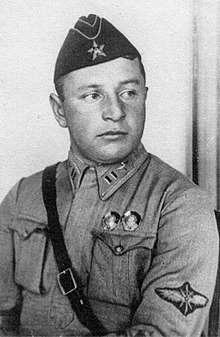Pavel Rychagov
Pavel Vasilievich Rychagov | |
|---|---|
 | |
| Native name | Павел Васильевич Рычагов |
| Born | 15 January [O.S. 2 January] 1911 Moscow, Russian Empire |
| Died | 28 October 1941 (aged 30) Samara, Soviet Union |
| Allegiance | |
| Service/ | |
| Years of service | 1928–1941 |
| Rank | General-Lieutenant of Aviation |
| Battles/wars | Spanish Civil War Second Sino-Japanese War Winter War |
| Awards | Hero of the Soviet Union |
| Spouse(s) | Mariya Nesterenko |
Pavel Vasilievich Rychagov (
Early life and education
Rychagov was born on 2 January 1911 in the village of Nizhnie Likhobory, which forms part of present-day Moscow. In 1928, he joined the Red Army, trained at the Leningrad Military College of the Air Forces, from which he graduated in 1930. In 1931, he enrolled for further training at the 2nd Military College for Pilots.[1]
Military career
Fighter pilot
For five years, Rychagov was an ordinary fighter pilot, building up skills before becoming commander of an aviation squadron in
The most intense part of Rychagov's career as a fighter pilot came in the Spanish Civil War. On 28 October 1936, Rychagov, leading a group of 15 Soviet pilots flying 25 Polikarpov I-15 aircraft, landed in Cartagena, Spain. A few days later, a further group of 10 pilots and 15 aircraft arrived in Bilbao.[5] Rychagov's fighter group saw their first action on 4 November. On that day, they shot down two Junkers Ju 52s and two Fiat CR.32s over Madrid, while no losses were reported among the Soviet pilots. During the next two days, Rychagov's pilots claimed 12 more victories, at the cost of two aircraft lost.[5]
However, on 16 November, Rychagov was shot down over Madrid by Fiat CR.32s,[5] and four days later the number of combat-ready Soviet aircraft in the area had dropped to 15. Seven had been lost in combat, two had been forced to land, and one was undergoing repair.[5] Rychagov, however, stayed on to fight into the spring of 1937. In December 1936 and January 1937 two more shipments of 30 Polikarpovs I-15s arrived in Spain, allowing the formation of a complete combat unit of four I-15 squadrons.[5] By the end of the war, Rychagov's fighter group claimed 40 victories overall.[1]
He returned to the
Commander
In December 1939, he was promoted to the rank of Major General; he was also appointed Commander of the 9th Air Force Army. He directed operations in the Winter War against Finland.[1]
In May 1940, a third Order of the Red Banner was presented to Rychagov. He was promoted to Lieutenant General several months later.[1]
By 1940, Rychagov was a member of the top administration of the Air Force. He was appointed Head of Red Army Air Force Administration and became a member of the Red Army Chief Military Council, a predecessor of the Stavka. Eventually, he was appointed Commander of the Air Force on 28 August 1940, succeeding Yakov Smushkevich.[1][2][3]
Death
Shortly before
On 24 June, two days after the German invasion began, Rychagov was arrested.[3] Some other high-profile arrests made by the NKVD in 1941 included:[7]
- 30 May: People's Commissar of Ammunition Ivan Sergeyev and Major General Ernst Schacht
- 31 May: Lieutenant General Pyotr Pumpur
- 7 June: People's Commissar of Armaments Boris Vannikov and Colonel General Grigory Shtern
- 8 June: Lieutenant General Yakov Smushkevich
- 18 June: Lieutenant General Pavel Alekseyev
- 19 June: Colonel General Alexander Loktionov
- 24 June: General Kirill Meretskov
- 27 June: Lieutenant General Ivan Proskurov
Rychagov was tortured and executed on 28 October 1941 along with his wife, air force Major Mariya Nesterenko.[4][7] Others who were executed that day included 20 other Soviet officers (including Rychagov's predecessors in the Air Force, Yakov Smushkevich and Aleksandr Loktionov),[8] Rychagov was exonerated posthumously in 1954.[1]
References
- ^ a b c d e f g h i "General Leytenant Pavel Vasilevich Rychagov HSU". Retrieved 24 September 2013.
- ^ ISBN 978-1-906537-18-0
- ^ a b c d Parrish 1996, p. 71–76.
- ^ a b c "1941: Twenty Red Army officers". 28 October 2010. Retrieved 24 September 2013.
- ^ ISBN 978-1-84603-981-2.
- ^ Sudoplatov, Paul (22 August 2005). Павел Судоплатов. Спецоперации. Лубянка и Кремль 1930-1950 годы (in Russian). Retrieved 3 October 2013.
- ^ a b Parrish 1996, p. 72.
- ^ Thomas, Nigel. World War II Soviet Armed Forces (1): 1939–41. Osprey Publishing.
Bibliography
- Parrish, Michael (1996). The Lesser Terror: Soviet State Security, 1939-1953. Greenwood Publishing Group. ISBN 9780275951139.
- Bortakovsky, Timur (2012). Расстрелянные Герои Советского Союза [Executed Heroes of the Soviet Union] (in Russian). Moscow: Veche. pp. 92–128. OCLC 784099768.
